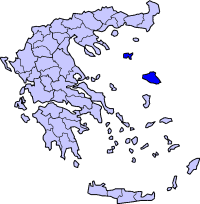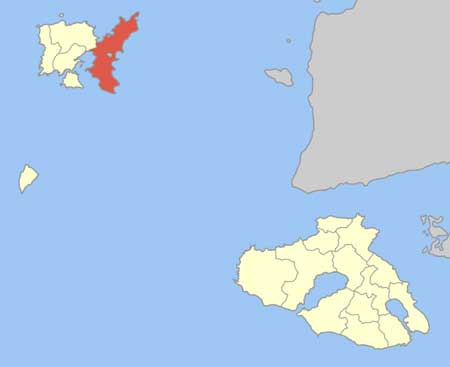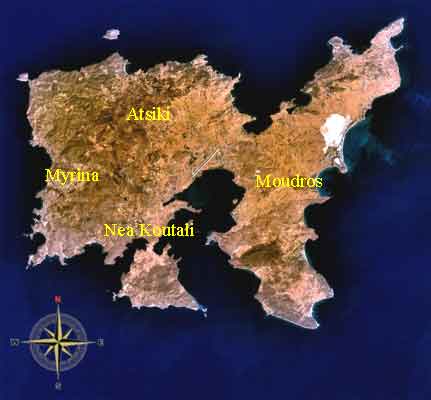.


Repanidi (Greek, Modern: Ρεπανίδι), accented form: Repanídi, older forms: -o and -on is a Greek village 20 km ENE of Myrina in the municipality of Moudros, Greece. Its 2001 population was 365 people. It is located in the northeast of the island of Lemnos. Its elevation is 30 m.
Nearest places
* Kontopouli, east (distance: 3 km)
* Kallithea, east
* Romanos, south (distance: about 2 to 3 km)
* Lychna, southwest
* Varos, west (distance: 3 to 4 km)
* Kotsinos, north (distance: 2 km)
Population
Year Population
1928 639
1981 393
1991 302
2001 365
History
The village was first mentioned as Repanidion in 1285 in a census record. Pteris (Πτέρις) or 'Pterin (Πτέριν) was a monastery in Lemnos near Tsimandria. Between all those had a chapel known as Odigitrias. Repanidi had a total of 28 parishes in which it had in all of Lemnos.
In 1418, Buondelmonti mentioned the village as Rapagnidi (Ραπανίδι) and was located in the outer part of the island. The next mentioning was Belon in 1548 in which he visited the island for several days and presented the realization of nearby paths in Hephaestia and the hill of the Lemnian land. It mentioned repeatedly as Rapagnidi and that mentioned on a map written in 1588. It wrote it founded a nearby port known as Ekato Kefalon (Εκατό Κεφαλών = The Hundred Heads) in which it was mentioned in a 1588 map as Ecato Cephales.
Eqaton Cephales was also mentioned in Buondelmonti in 1418 in Hephaestia hill. Its port was founded and was used during the years of Piri Reis in 1521, in which it was mentioned in the map as Limãn-i-jüz baš (Port of Ekato Kefalo). Belon tried as in Repanidi lost six rifles on Kotsinos hill and three was a port, when he was fishing with a hook and a net.
That information that mentioned as the village was not located in a present day location and was founded near Agios Ypatios. Near the village founded its only forest in Lemnos, it contained beech and oak trees, the fruits which was used for skin production. In 1611, it was mentioned that the pirates plundered a sailboat with 13 sailors in which they were headed from Limnos to Samothrace, its information did not receive when it was raided. Several raids occurred until today in the area.
The village was also mentioned: by a doctor, Albacario, (late 16th century) as Raponidi in which he was travelling to the Lemnian land, on the map of Choiseul-Gouffier (1785), Herpagni, from Lacroix (1820) as Rapanidi and from Conze in 1858 as Drepanidi. The last one did not found the same village with Agios Ypatios, when it was mentioned in English maps of the time. Here it has the sources, even the 1858 map which was mentioned, in these old maps which mentioned even Anypati. The movine did not happen and became much older during the beginning of the 19th century.
Conze visited the port's spring of the Lemnian land and walked next to the bumps, a jar which was scaled in a rock (vine), in which left the must for boiling before it was poured into the barrel. He used in an ancient tomb-like vessel that came from Hephaestia, he asked a cafe customer in the village, Anagnostis Papasavvas. Later it was sold to the Louvres. As Drepanidi which was written in the maps of De Launay in 1898 but Fredrich's 1904 map mentioned correctly as Repanidi.
Name
In older sources as Repandion and Rapanidi (Ραπανίδι), it was known from the 13th to the 16th centuries and founded in a communal census from the 19th century with its forms: Repanidi, Rapanidi, Ropanidi, Repanidi (Ρεπανήδι, with an eta in the first i) and Repanidi. Its village name derived from a plant known as a radish, it meant it derived from a plant name.
Some different sources which it had for some times stated (from creeping in a scythe of the oak) did not made it. Its alternate forms of the name which drove into erroneous etymologies, in which it said in weakness of the travellers that brought correctly the name which was known from the main parts of its inhabitants. The writer Drepanidi of Conze and De Launay drove takingly from an alternate form "st' repanid", Herpagni which was known in the map of Choisseul-Gouffier derived from an illiterate "Erpanid'" in which is famous as from other villages: "Ormanou - Romanou" and "Orospoul - Rossopouli".
19th century
From Repanidi descands Athanasios Repanidiotis in which he had an adventurous life. In the mid 19th century, the village was organized. In 1844, its local council which belonged to the city for resulted sources from the island's judge ran and counselled the village Nikolas Plafas. In the village had a school which was opened in 1830-20, mainly in the building featured a windmill and later some pots from Kotsinos. In 1875, the school building was built and in 1879, the school became communal. It was two-tear and became a five-tier in 1912.
In 1854, the village priest was named Giorgos. In 1856, 147 men ages 18 to 60 paid 4,704 gros for their enlistment in to the army, in 1863 and in 1874, 94 Christian families went under population stagnation. In 1874, it had 118 houses, its sourced was educated from a rural volume, though to the late 19th century, it mentioned ship owners from Repanidi including Meleounis (Μελεούνης).
In the final years of Turkish rule, it opened a post office in which survives a note with the date 16-9-1912 and the place name REPANIDI (MOUDOS), one of the village that belonged to the old municipality of Moudros. Repanidiotes received a member into the regional council.
Modern years
During the interwar year, the village had a small growth. In 1928, the population was 639 people and in 1931 built a new school building with the funding by the Repanidioiti Council of the USA "Agios Georgios", in which employed a pickle company by Savvas Papadopoulos and Georgios Hadjiandoniou. It ran until 1990 in which it united with the school in Kontopouli. From 2006, the school building runs as a Children's Educational Factory.
The new monastery of Saint George or Agios Georgios began to built in 1928, which was completed in 1948. It is built out of stone with marble decorative sources and the builder which was known as Vassilis Kafkis (Βασίλης Καυκής). Its residents praised Angelis Michelis in a small historic-folklore member which was written in 1934:
"Οι κάτοικοι του Ρεπανιδίου άπαντες σχεδόν είναι κτηματίαι ευσεβέστατοι, με απλούστατα και πατριαρχικά ήθη και έθιμα. Από την γυναίκα ποτέ δεν λείπει το άσπρο φακιόλι, οι δε άνδρες ονειδίζονται από τους κατοίκους των πέριξ χωρίων διότι δεν εφόρουν ζωνάρια. Οι Ρεπανιδιώται είναι εις άκρον φιλοξενώτατοι, εις άκρον διασκεδαστικοί και δεν υστερούν εις τα εθνικά δημώδη τραγούδια."
"Its residents of Repanidi... ...From the ladies which never said from the white letter... ...cultural folk music.
After World War II, immigration strangled the village, its population declined until the 1980s and it was 302 in 1991. The village has a small hotel and rented rooms. It runs a cultural council and once had a soccer club AO Repanidiou. In Athens it has a council with a remarkable actions.
From Repanidi includes the modern writer Kostas Zafiriou (Κώστας Ζαφειρίου), which wrote a book Paramytha gia tin Aithaleia kai alles istories (') Patras 2004, which is inspired from Limnos.
Gallery
Bibliography
* Tourtsopoulou-Stefanidou Vasilili, Taxidiotika kai geografika keimena gia to niso Limnos (15os-20os aionas) (Ταξιδιωτικά και γεωγραφικά κείμενα για τη νήσο Λήμνο (15ος-20ος αιώνας)' = Travelling and Geographic Sources of Lemnos Island (15th-20th Centuries)) Thessaloniki, 1986.
* Lemnos CD: Limnos agapimeni (Λήμνος αγαπημένη = Loveable Lemnos)
* Theodoros Belitsos, I Limnos kai ta choria tis (Η Λήμνος και τα χωριά της = Lemnos and its Villages), 1994
* Angelis Michelis Repanidi, Limnos, p 1019-1021 (November 11 to 25, 1934)
|
Municipalities and communities of the Lesbos Prefecture
Agia Paraskevi | Agiasos | Atsiki | Eresos-Antissa | Evergetoulas | Gera | Kalloni | Loutropoli Thermis | Mantamados | Mithymna | Moudros | Myrina | Mytilene | Nea Koutali | Petra | Plomari | Polichnitos |
| Municipal unit Moudros |
|---|
| Municipal Community Moudros |
| Κουκονήσιο, το (νησίς) |
| Moudros (Μούδρος, ο) |
| Community Kalliopi |
| Kalliopi (Καλλιόπη, η) |
| Community Kaminia |
| Voroskopos (Βοροσκόπος, ο) |
| Kaminia (Καμίνια, τα) |
| Community Kontopouli |
| Agios Alexandros (Άγιος Αλέξανδρος, ο) |
| Agios Theodoros (Άγιος Θεόδωρος, ο) |
| Kontopouli (Κοντοπούλιον, το) |
| Community Lychna |
| Anemoessa (Ανεμόεσσα, η) |
| Lychna (Λύχνα, τα) |
| Community Panagia |
| Kortisonas (Κορτισώνας, ο) |
| Panagia (Παναγία, η) |
| Community Plaka |
| Plaka (Πλάκα, η) |
| Community Repanidi |
| Kotsinas (Κότσινας, ο) |
| Repanidi (Ρεπανίδιον, το) |
| Community Roussopouli |
| Roussopouli (Ρουσσοπούλιον, το) |
| Community Romano |
| Romano (Ρωμανόν, το) |
| Community Skandali |
| Skandali (Σκανδάλιον, το) |
| Community Fisini |
| Agia Sofia (Αγία Σοφία, η) |
| Fisini (Φισίνη, η) |
| Ancient Greece
Science, Technology , Medicine , Warfare, , Biographies , Life , Cities/Places/Maps , Arts , Literature , Philosophy ,Olympics, Mythology , History , Images Medieval Greece / Byzantine Empire Science, Technology, Arts, , Warfare , Literature, Biographies, Icons, History Modern Greece Cities, Islands, Regions, Fauna/Flora ,Biographies , History , Warfare, Science/Technology, Literature, Music , Arts , Film/Actors , Sport , Fashion --- |
Retrieved from "http://en.wikipedia.org/"
All text is available under the terms of the GNU Free Documentation License



